Hurricane Eta was a deadly and erratic Category 4 hurricane that devastated parts of Central America in early November 2020. The record-tying twenty-eighth named storm, thirteenth hurricane, and sixth major hurricane of the extremely-active 2020 Atlantic hurricane season, Eta originated from a vigorous tropical wave in the eastern Caribbean Sea on October 31. The system rapidly organized as it progressed west, with the cyclone ultimately becoming a Category 4 hurricane on November 3. With a peak intensity of 150 mph (240 km/h) and 922 millibars, it was the third most intense November Atlantic hurricane on record, behind the 1932 Cuba hurricane and Hurricane Iota, the latter of which formed just two weeks later in the same area. Some weakening took place as the system made landfall near Puerto Cabezas, Nicaragua, late that same day. Eta rapidly weakened to a tropical depression and briefly degenerated to a remnant low as it meandered across Central America for two days, before regenerating into a tropical depression and moving north over water. The storm later reorganized over the Caribbean as it accelerated toward Cuba on November 7, making a second landfall on the next day. Over the next five days, the system moved erratically, making a third landfall in the Florida Keys, on November 9, before slowing down and making a counterclockwise loop in the southern Gulf of Mexico, just off the coast of Cuba, with the storm's intensity fluctuating along the way. After briefly regaining hurricane strength on November 11, the system weakened back to a tropical storm once more, before making a fourth landfall on Florida on the next day, and proceeding to accelerate northeastward. Eta subsequently became extratropical on November 13, before dissipating off the coast of the Eastern United States on the next day.

Eta at peak intensity just east of Nicaragua early on November 3
Tropical Storm Eta at the beginning of its rapid intensification phase east of Nicaragua on November 1.
Hurricane Eta shortly before landfall in Nicaragua on November 3. Its rainbands covered most of Central America.
Eta shortly after regaining tropical storm status, approaching the Cayman Islands and Cuba on November 7.
The Saffir–Simpson hurricane wind scale (SSHWS) classifies hurricanes—which in the Western Hemisphere are tropical cyclones that exceed the intensities of tropical depressions and tropical storms—into five categories distinguished by the intensities of their sustained winds. This measuring system was formerly known as the Saffir–Simpson hurricane scale, or SSHS.
Image: Nicole 2022 11 10 0620Z colored
Image: Agatha 2022 05 30 1700Z
Image: Grace 2021 08 21 0610Z
Image: Lidia 2023 10 10 2120Z








